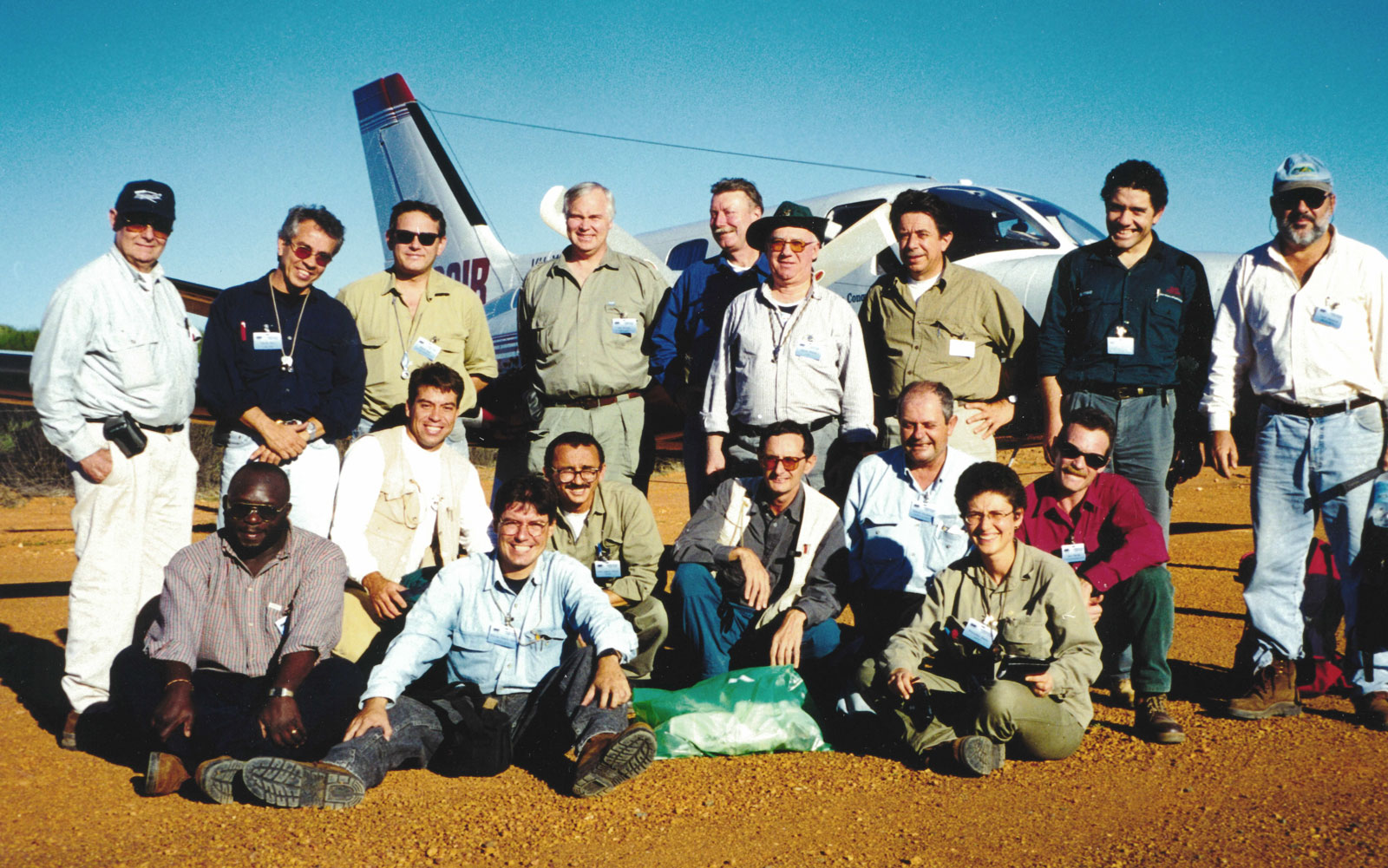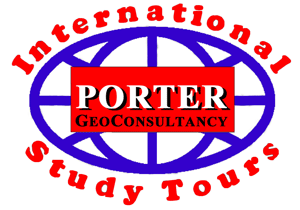| |||||||||||
| |||||||||||
| |||||||||||
|
Image: Module 1 group at Golden Grove, WA.

By Mike Porter
The shrill of the alarm brought a sudden return to consciousness. Then a slow, seeping realisation, of where, of when, and of why.
In the pre-dawn darkness the red glow of the bedside clock display showed 4:45 AM. This was Mt Isa. The Verona Inn. It was Friday. And OzTour, the Australian Mineral Foundation's OzTour '99 International Study Tour. Then a thrill of anticipation. Today the great mines of Mt Isa were to be visited. The last of the trio of giant sediment hosted zinc-lead-silver ore deposits in Northern Australia. On the previous two days the group had been given superb visits to each of the other two. First to MIM's HYC orebody at McArthur River in the Northern Territory, then across the Queensland border to Pasminco's Century Project. Today the 18 geologists on the tour, too many to be taken underground as a single group, would be split into two parties of nine. The first was to go down the Hilton-George Fisher mine complex, 22 km to the north, the second to the Mt Isa Lead mine, just across the Leichhardt River from town. The Hilton party was due at the mine gate by 6:00 am to meet Nick Davies, the Senior Geologist for the complex, and catch an early cage down the shaft. But for now, the imperative was to get up and be downstairs for the specially arranged early breakfast at 5:00 am, and then onto the bus for a 5:30 am departure. Downstairs in the restaurant the group had gathered for breakfast. For some this was only their third morning on the tour. These were the six that had joined in Darwin on Tuesday night to take the second module alone. This 11 day module would encompass 9 ore deposits, and end in Melbourne in just over a week, having been as far south as Western Metal's Hellyer mine in Tasmania. The main group had flown up to Darwin from Geraldton on Tuesday, lunching en route on the water-front at Broome in northwestern Western Australia. The first module, which started in Adelaide, and lasted 9 days, had ended in Geraldton that same Tuesday morning, when the six taking that module only had left the tour. In all, the tour would take in 16 of Australia's most important base metal and gold mines, supported by 4 day long overview seminars and field workshops presented by renowned experts. As is now the norm for this International Study Tour series, the participants were from around the world. They came from three countries in South America, three in Africa, from North America, South-east Asia and Australia, and represented a wide diversity of experience, knowledge and perspective which they contributed to discussions on tour. They were from the more progressive companies who appreciate the need to develop their key staff to maintain a competitive advantage over their less forward looking rivals. In the three weeks of the full tour they travelled together for some 11 500 km, mostly in two chartered, fully pressurised, twin turbine Cessna Conquest aircraft. These cruised at 550 km/hr, and an altitude of 30 000 feet, devouring the long distances, and landing directly at mine airstrips. The size of the tour group was partly determined by the 18 seats available on these aircraft, but also by the number that could be accommodated on underground visits, and by the effective size of a group that must interact and work together. The tour had in fact been over-subscribed, with a number of applications for each of the modules of necessity being declined. A Joint Tour
While the detailed planning, organisation and management of OzTour '99 was all undertaken by the AMF, it was in fact a joint tour, conducted in cooperation with the Agencia para o Desenvolvimento Technologico da Industria Minera Brasileira (ADIMB of Brazil).
The content and itinerary were initially negotiated between ADIMB and AMF. ADIMB had promoted the tour through its membership, representing the bulk of the mineral industry in Brazil. All of the participants from outside of Brazil were recruited by the AMF. ADIMB is a Brazilian organisation, somewhat analogous to both the AMF and AMIRA. It's mission is to promote and develop the technical and scientific capacity, and human resources of the Brazilian mineral industry. As such it is involved in the further education of mineral industry professionals, and with promoting research. Eleven of the tour participants were from ADIMB member companies. They took part in all of the tour, from its commencement in Adelaide on Sunday 9 May, up to and including the visit to Broken Hill on Thursday 27 May. The full tour, and the second module, ended two days later on Saturday 29 May, after taking in a further two mines. Future tours will be similarly jointly promoted, with the next, Pacific Gold '99 being supported by the AMF, ADIMB, the Geological Society of South Africa and the Mineral Deposits Division of the Geological Association of Canada. The Ore Deposits
The theme of the tour was "Key Australian Base Metal and Gold Deposits". It encompassed a representative selection of the countries most important mines.
The first module concentrated on "Base Metals and Gold in the Archaean and Proterozoic Shield of South Western Australia". It commenced with WMC's giant Olympic Dam copper-uranium operation in the Gawler Craton of northern South Australia. Next came four nickel orebodies in the Yilgarn Craton of Western Australia covering each of the main exploited styles. nbsp; These were the Mt Keith disseminated sulphide mine (WMC), the massive sulphides of Kambalda (WMC), the silicate laterites at Murrin Murrin (Anaconda Nickel) and the oxide laterites at Cawse (Centaur Mining and Exploration). Two important gold mines were included, the KCGM Super Pit in Kalgoorlie and the Bronzewing mine of Great Cental Mines. The final visit was to the Normandy Golden Grove copper-zinc mine in the Murchison Province of the Yilgarn. The second module focussed on "Base Metals and Gold in the Proterozoic and Phanerozoic Mobile Belts of Eastern Australia". It began with the great northern Australian trio of sediment hosted zinc-lead-silver deposits, the HYC orebody at McArthur River (MIM), the Century Project (Pasminco) and the Hilton-George Fisher and Mt Isa Lead mines at Mt Isa (MIM). Next were the Mt Isa copper orebodies (MIM) and the Ernest Henry copper-gold deposit (MIM-Pasminco). nbsp; Then the high grade metamorphic hosted lead-zinc-silver mines of Cannington (BHP) in Queensland and Broken Hill (Pasminco) in New South Wales. These were followed by the transgressive, sediment hosted massive sulphide zinc-lead-silver deposit at Elura (Pasminco), also in NSW, and the Hellyer volcanic hosted copper-lead-zinc-silver-gold orebody of Western Metals in Tasmania. Each visit entailed a briefing on the ore deposit, its geological setting, the mineralisation and mining, followed by an opportunity to study the ore and host rocks in the mine. At most operations, drill core through the ore and surrounding country rock was also available, while in addition at some, surface traverses of the deposit were conducted, over and away from the mine. At a number of sites this was the first group to have been granted a visit. Almost without exception the visits were superb, a reflection of the professionalism of the Australian industry. The AMF and all of the tour participants are indebted to the companies and mine staff for their cooperation, and the time and hospitality they extended to the group. Seminars, Workshops and Experts
In addition to the mine visits there were four seminars and field workshops, as well as a half day field traverse to provide an overview of the geology and mineralisation of the regions visited.
The first was presented by Primary Industry and Resources SA who provided five expert speakers for a half day seminar at the AMF in Adelaide covering South Australia, and the Gawler Craton in particular. In Perth, high level presentations were delivered at a full day seminar. They included informed speakers from the Geological Survey of WA, the Key Centre for Strategic Mineral Deposits at the University of Western Australia, the CSIRO, and the CRC-LEME. These covered the tectonics and geology of the Yilgarn and Pilbara, the Archaean gold deposits of WA, the development and controls of nickel mineralisation and the development and behaviour of metals in the regolith. The Geological Survey of WA had earlier conducted a regional traverse across the Norseman-Wiluna Greenstone Belt just south of Kalgoorlie. In Mt Isa, well known Brisbane based consultant Geoff Derrick provided a comprehensive overview of the geology and metallogeny of the Mt Isa Block and McArthur Basin, followed by a field traverse of the key hosts and gossan zones at Mt Isa. At Broken Hill, Barney Stevens of the NSW Department of Mineral Resources gave an excellent overview of the geology and mineralisation of the Curnamona Craton, Willyama Block and Broken Hill district, followed by a traverse of the key lithologies, lode horizons and gossan outcrops at Broken Hill. The Series Continues
This was the seventh such tour conducted by the AMF over the last two and a half years. In all, these have visited more than 85 of the world's most important ore deposits, in North and South America, Africa, Europe, Asia and Australasia.
These tours have been attended by geologists from all of the same continents and from most of the worlds most important mining and exploration companies. Four future tours are currently in various stages of development. These are: Pacific Gold '99 taking in more than 20 of the most important gold and gold-copper deposits around the Pacific margin, in the Western Pacific, Western North America and Andean South America, as three separate modules, in September-October 1999. NewGold '99 which will immediately follow the New Generation Gold Deposits conference in Perth in late November. It will visit new discoveries and mines in WA, some of which are the subject of presentations at the conference, as well as established and better understood mines in the same districts. Nickel 2000 that will visit the worlds most important nickel deposits, both laterite and sulphide, as three modules in mid 2000. Africa 2000 taking in the gold deposits of East and West Africa, in two modules, in late 2000. Mike Porter of Porter GeoConsultancy Pty Ltd designed, organised and led this International Study Tour for the Australian Mineral Foundation. | |||||||||||











